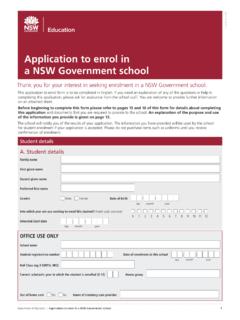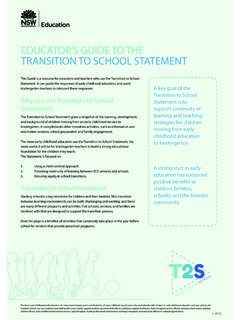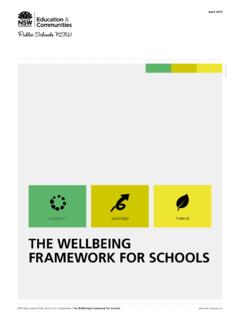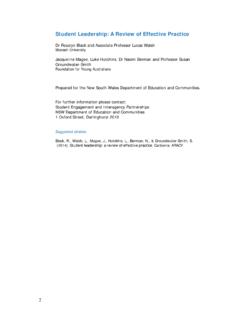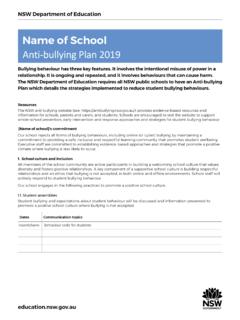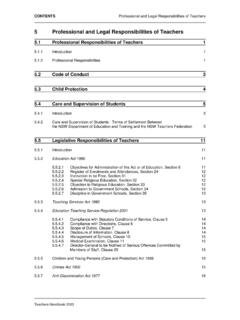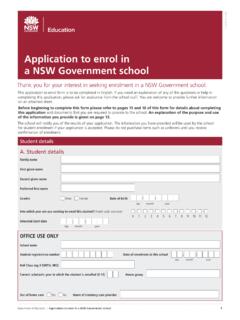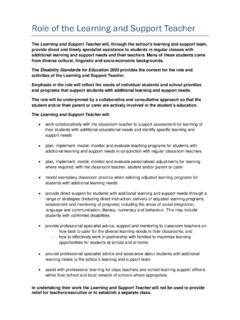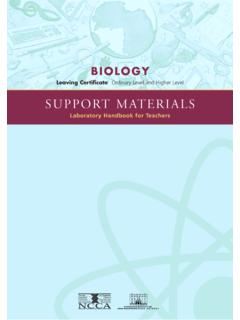Transcription of Policy Standards for Curriculum Planning and Programming ...
1 Policy Standards for Curriculum Planning and Programming , Assessing and Reporting to Parents K-12. (Updated July 2018). Context These Policy Standards outline the requirements for all NSW public schools to plan Curriculum , develop programs, assess and report to parents in line with the Education Act 1990; the NSW. Education Standards Authority (NESA) syllabuses; credentialing requirements; obligations under the Disability Discrimination Act 1992; and the Disability Standards for Education 2005. Curriculum Planning and Programming will account for the needs of every student.
2 Curriculum options and adjustments 1 are negotiated to reflect the learning and support needs of students whose learning is impacted by disability. The English as an Additional Language or Dialect (EAL/D) advice has been revised to align with the current Policy advice to schools. 1. Curriculum Planning and Programming Curriculum and allocation of time Years K-6. Learning programs, based on NESA syllabuses, are to be provided to address each learning area in each year of schooling. In primary schools, the six Key Learning Areas (KLA) are: creative arts English human society and its environment (incorporating history and geography).
3 Mathematics personal development, health and physical education science and technology. In providing Curriculum , schools are to ensure that priority is given to English and mathematics. Schools have flexibility in how they deliver learning programs, for example through integrated programs, provided that: approximately 50% of time is allocated for English and mathematics and 40%. of time for the other KLAs and sport as part of the 40% allocation, schools are to include 150 minutes per week for planned physical activity, including a minimum of one hour for sport in Years 3 6.
4 Provision is made for Special Religious Education (SRE) and Special Education in Ethics (SEE) in each primary year, where authorised personnel from approved providers are available. 1. Adjustments are measures or actions taken in relation to teaching, learning and assessment that enable a student whose learning is impacted by disability to access syllabus outcomes and content on the same basis as their peers. Adjustments reflect the learning and support needs of the individual student. 1. Years 7-10. The department provides annual updates to schools regarding the requirements for the Record of School Achievement (RoSA).
5 This commenced in 2016. Learning programs, based on NESA syllabuses, are to be provided for each subject or course in each year of schooling. In providing this Curriculum program, schools will meet the requirements of NESA for students to gain the RoSA. Schools must refer to the requirements, rules and procedures as detailed on the Assessment, Certification and Examination (ACE) website to ensure the eligibility of students. Schools have flexibility in how they deliver learning programs, for example, through integrated programs.
6 Where schools have implemented integrated programs of learning they must be able to demonstrate that the minimum required hours for each of the learning areas have been met. Provision is to be made for SRE in each of Years 7 to 10, where authorised personnel from approved providers are available. The following summarises the combined NESA and department minimum requirements for government schools when providing Curriculum . Requirements in hours / minutes English (7-10) 500 hours Mathematics (7-10) 500 hours Science (7-10) 500 hours HSIE (7-10) 400 hours distributed as: o Geography (7-8) 100 hours o History (7-8) 100 hours o Geography (9-10) 100 hours o History (9-10) 100 hours Language 100 hours in a continuous one-year period Technology Mandatory (7-8) 200 hours Music (7-10) 100 hours Visual Arts (7-10) 100 hours PDHPE (7-10) 300 hours (delivered across 7-10).
7 Additional Studies (Electives) 400 hours including Board Developed or School Developed Board Endorsed courses Planned physical activity including 150 minutes per week planned weekly sport Years 11-12. The department provides annual updates to schools regarding the requirements for the Higher School Certificate (HSC). 2. Learning programs, based on NESA syllabuses, are to be provided for each subject or course in each year of schooling to ensure students meet the requirements for the award of HSC. In addition to NESA requirements for students to gain a HSC, government schools are to provide students with the following: Life Ready a 25 hour course SRE where authorised personnel from approved providers are available.
8 Schools are encouraged to provide Year 11 and 12 students with weekly access to a minimum of 150 minutes of physical activity, including sport. Complying with the Education Act 1990 and NESA requirements All schools are required to maintain documentation that provides evidence of compliance with the NESA syllabuses and reflect the obligations to students under the Disability Discrimination Act 1992 and the Disability Standards for Education 2005. Years K-6 (Early Stage 1- Stage 3). Essential elements to be included in a school's documented Curriculum : syllabus outcomes and requirements in scope and sequence overviews syllabus content and teaching activities in teaching programs.
9 Years 7-10 (Stage 4 Stage 5). Essential elements to be included in a school's documented Curriculum : timetables showing the allocation of time and teachers for each year/class the total number of hours allocated to each course syllabus outcomes and requirements syllabus content and teaching activities in teaching programs assessment policies and procedures which comply with the requirements documented on the ACE website, NESA official notices and department memorandums confirmation that the school has policies for disability provisions in accordance with the ACE website.
10 Years 11-12 (Stage 6). Essential elements to be included in a school's documented Curriculum : learning programs, based on NESA syllabuses (or approved courses), are to be provided to address each subject provided in Years 11 and 12. timetables showing the allocation of time and teachers for each year/class the total number of hours allocated to each Preliminary and HSC course courses of study for each student each year that comply with a pattern of study for Year 11 and 12, as described on the ACE website for candidates for the HSC (ACE.)
